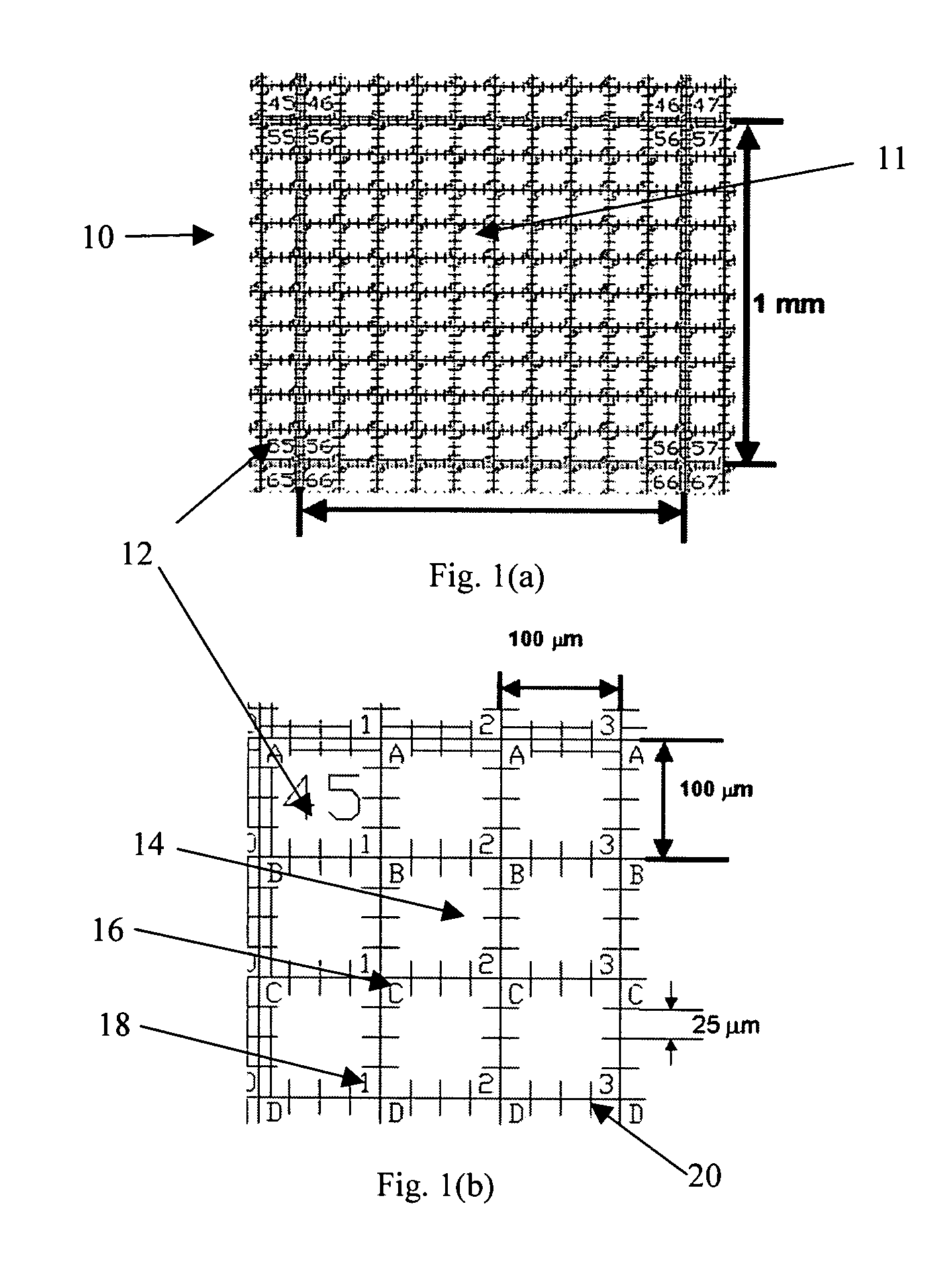Micro-pattern embedded plastic optical film device for cell-based assays
a cell-based assay and micro-pattern technology, applied in the field of biological research and drug discovery, can solve the problems of high cost, high and high cost of this method to make, and achieve the effect of reducing the cost of engraved slides and slips and reducing the cost of production
- Summary
- Abstract
- Description
- Claims
- Application Information
AI Technical Summary
Benefits of technology
Problems solved by technology
Method used
Image
Examples
example 1
Making Micro-Pattern Embedded Optical Film
[0052]The micro-pattern embedded plastic optical film consists of two layers. The base substrate is a 10-mil (namely, 0.010 inch thick) polycarbonate film: DE 1-1D Makrofo polycarbonate Gloss / Gloss with liners (Tekra Co., New Berlin, Wis.). The second layer is a clear plastic with micro-pattern formed on its surface.
[0053]The process of fabricating the micro-pattern embedded film consists of the following steps.[0054]1. Make a master tool that has a negative image of FIG. 1.[0055]2. Prepare a UV polymerizable solution. (Ex. Lens bond, SK-9 from Summers Optical, Hatfield, Pa.)[0056]3. Cast the UV polymerizable solution between the base substrate and the master tool.[0057]4. Expose the assembly made in step 3 with UV light, resulting in a film with micro-pattern embedded on its surface.[0058]5. Remove the micro-pattern embedded plastic optical film from the master tool.
[0059]Steps 3 to 5 may be repeated to produce multiple micro-pattern embedd...
example 2
Cell Culture on Micro-Pattern Embedded Optical Film
[0061]The micro-pattern embedded film was placed in a cell culture dish and illuminated by UV light over night in a tissue culture hood for sterilization. Neuroblastoma (CCL-131 from American Type Culture Collection, Manassas, Va.) was cultured following standard protocols. FIG. 7 is a phase contrast image of a cluster of Neuroblastoma cells 102 cultured on a micro-patterned optical film 100. Cell growth 104 is observed. Shown in FIG. 7 are a column identification number 106 and a row identification letter 108. Tick marks 110 are also visible.
Cell-Based Assay Device with Micro-Pattern Embedded Optical Film
[0062]One embodiment of the present invention is a cell assay device 120 with micro-pattern embedded plastic optical film 121, as shown in FIG. 8a. The micro-pattern embedded plastic optical film 121 provides a surface for identification and measurement of cells, while a supporting component 122 provides mechanical strength for han...
example 3
Cell Culture on a 24-Well Micro-Pattern Embedded Assay Device
[0079]A 24-well micro-pattern embedded cell assay plate 180 was placed in a tissue culture hood, illuminated by UV light over night for sterilization. Neuroblastoma cells (CCL-131 from American Type Culture Collection, Manassas, Va.) were cultured following standard protocols. FIG. 13 is a phase contrast image of the Neuronblastoma cells on one of the 24 wells. The cell body 190 and axon 192 are clearly visible in the image. Tick marks 194 and 195 are 25 μm apart. The tick marks are used to directly estimate the length of the axon.
Method of Making a Micro-Pattern Embedded Assay Device
[0080]The micro-pattern embedded plastic optical film can be attached to the liquid handling component by various methods. The requirements on the attachment material are to provide sufficient mechanical strength to hold the parts together, and not to release materials into the cell culture media during experiments.
[0081]FIG. 14 illustrates a ...
PUM
| Property | Measurement | Unit |
|---|---|---|
| height | aaaaa | aaaaa |
| height | aaaaa | aaaaa |
| size | aaaaa | aaaaa |
Abstract
Description
Claims
Application Information
 Login to View More
Login to View More - R&D
- Intellectual Property
- Life Sciences
- Materials
- Tech Scout
- Unparalleled Data Quality
- Higher Quality Content
- 60% Fewer Hallucinations
Browse by: Latest US Patents, China's latest patents, Technical Efficacy Thesaurus, Application Domain, Technology Topic, Popular Technical Reports.
© 2025 PatSnap. All rights reserved.Legal|Privacy policy|Modern Slavery Act Transparency Statement|Sitemap|About US| Contact US: help@patsnap.com



